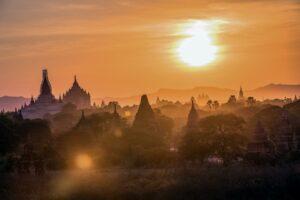Fodor's Expert Review Wat Xieng Thong
Luang Prabang's most important and impressive temple complex is Wat Xieng Thong, a collection of ancient buildings near the tip of the peninsula where the Mekong and Nam Khan rivers meet. Erected in 1560, the main temple is one of the few structures to have survived centuries of marauding Vietnamese, Chinese, and Siamese armies, and it's one of the region's best-preserved examples of Buddhist art and architecture. The intricate golden facades, colorful murals, sparkling glass mosaics, and low, sweeping roofs of the entire ensemble of buildings (which overlap to make complex patterns) all combine to create a feeling of harmony and peace.
The interior of the main temple has decorated wooden columns and a ceiling covered with wheels of dharma, representing the Buddha's teaching. The exterior is just as impressive thanks to mosaics of colored glass that were added in the 1950s. Several small chapels at the sides of the main hall are also covered with mosaics and contain various images... READ MORE
Luang Prabang's most important and impressive temple complex is Wat Xieng Thong, a collection of ancient buildings near the tip of the peninsula where the Mekong and Nam Khan rivers meet. Erected in 1560, the main temple is one of the few structures to have survived centuries of marauding Vietnamese, Chinese, and Siamese armies, and it's one of the region's best-preserved examples of Buddhist art and architecture. The intricate golden facades, colorful murals, sparkling glass mosaics, and low, sweeping roofs of the entire ensemble of buildings (which overlap to make complex patterns) all combine to create a feeling of harmony and peace.
The interior of the main temple has decorated wooden columns and a ceiling covered with wheels of dharma, representing the Buddha's teaching. The exterior is just as impressive thanks to mosaics of colored glass that were added in the 1950s. Several small chapels at the sides of the main hall are also covered with mosaics and contain various images of the Buddha. The bronze 16th-century reclining Buddha in one chapel was displayed in the 1931 Paris Exhibition. The mosaic on the back wall of that chapel commemorates the 2,500th anniversary of the Lord Buddha's birth with a depiction of Lao village life. The funerary carriage house near the compound's east gate, with a gilded facade, contains the royal family's funeral statuary and urns, including a 40-foot-long wooden funeral carriage.
READ LESS




